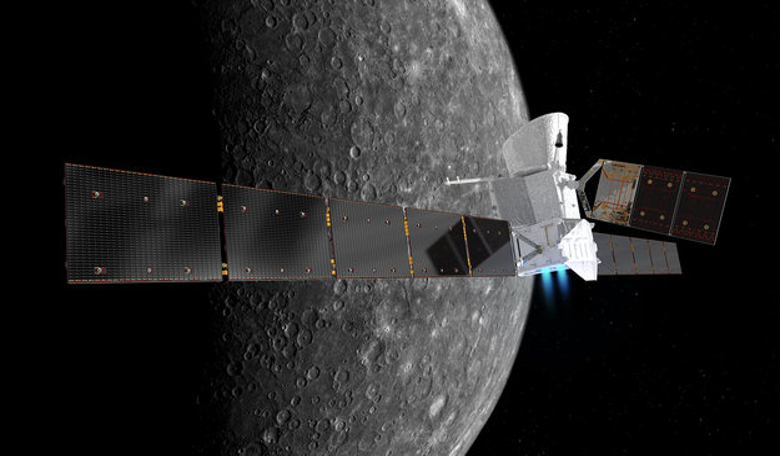After years of planning and preparation, mission teams are getting ready to wave goodbye to BepiColombo – ESA’s joint mission with the Japan Aerospace Exploration Agency (JAXA), that is destined for a long and complex journey before it reaches the innermost planet of the Solar System, Mercury, in 2025.
Mercury is a world of extremes and uniqueness. For starters, the planet has the smallest axial tilt of any other planet in the Solar System – just 0.01 degrees. Earth for comparison has an axial tilt of 23 degrees, while Venus’s tilt is a whopping 117 degrees, meaning its north pole is effectively pointing 'down.’
This tiny tilt also ensures that Mercury has permanently shadowed regions at its poles that never see the light of day. This allows ice to exist on its surface and it is the reason that this small and very dense planet has no seasons like Earth.
The tilt, or lack of it, also gives Mercury another curious consequence; on Mercury’s equator, there are two regions that are 180 degrees apart, which always have the Sun directly overhead when the planet is closest to the Sun. If you could stand at these points, then the Sun would appear to be almost stationary overhead for two to three weeks. This phenomenon is due to the planet’s orbital velocity (the speed that is travels around the Sun) being equal to that of its rotational velocity (the time that it takes to complete one revolution around its axis of rotation) for that period.
And if that wasn’t enough then Mercury is also unique in that it rotates three times about its spin axis for every two orbits around the Sun. This means that any given point on Mercury experiences one solar day every two years.
And all of this without mentioning the obvious dilemma of being so close to the Sun; scorching hot surface temperatures that can reach as high as +430 degrees celsius (806 Fahrenheit).
It is clear then, why this planet is so intriguing to study and why, to date, Mercury has remained the least explored terrestrial planet of the Solar System; its proximity to the Sun. It is not just a question of shielding a spacecraft from the furnace-like conditions it will experience, but the spacecraft must also be able to cope with the enormous gravity from the Sun that acts like a giant magnet pulling the small spacecraft towards it.
Nonetheless, this has not put off scientists and engineers from ESA and JAXA, who have designed a spacecraft capable of surviving these hellish attributes. “The closer we get to the Sun the more we are constricted in our path,” explains Frank Budnik from the mission’s Flight Dynamics team.
“For example, BepiColombo’s large solar arrays need to be tilted at just the right angle to get enough sunlight to power the high-energy demand of the propulsion system and keeping the spacecraft running. At the same time, they mustn't get too much sunlight, or they could be beyond their limits.”
“There is only a small corridor in which the solar arrays can be operated to fulfil both of these constraints,” adds Budnik.
Before BepiColombo gets there however, it will undertake nine planetary flybys at a top speed of 60 kilometres per second, using electric propulsion driven thrust and the gravity of the inner planets in its nine billion kilometre journey to the iron-laden, rocky inner planet.
“Mission teams have spent months simulating BepiColombo’s unique and complex journey,” explains Operations Manager Elsa Montagnon. “Taking turns, in 12-hour shifts, we have been practising the spacecraft’s various launch and early mission processes and manoeuvres in real-time so we are prepared for every possible eventuality.”
BepiColombo is set for launch at 01:45 GMT (03:45 CEST) on 20 October, on board an Ariane 5 rocket. Once the spacecraft separates from the rocket's 'upper stage', teams at ESOC will take over to get the spacecraft into normal operational mode — a process that is expected to take about four days. Then hopefully it is bon voyage for the next seven years as Bepi cruises to its hostile destination.











